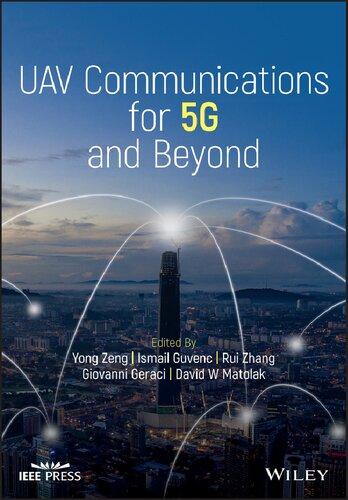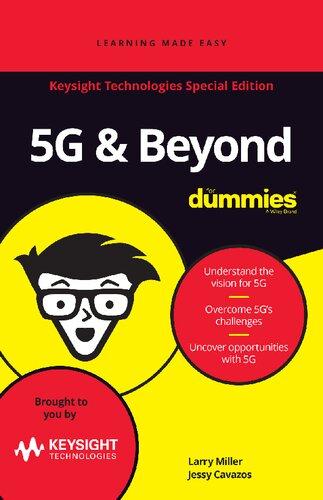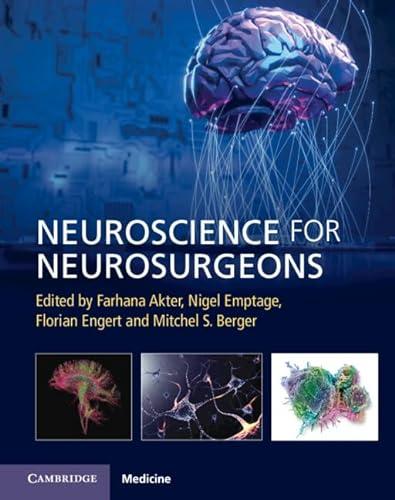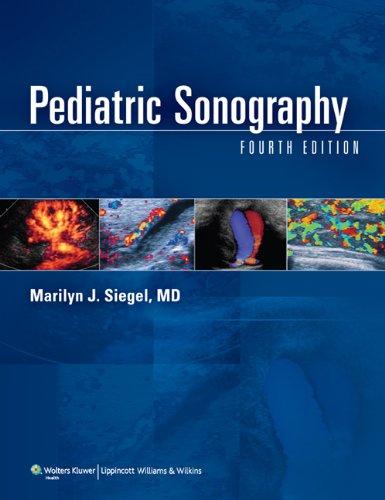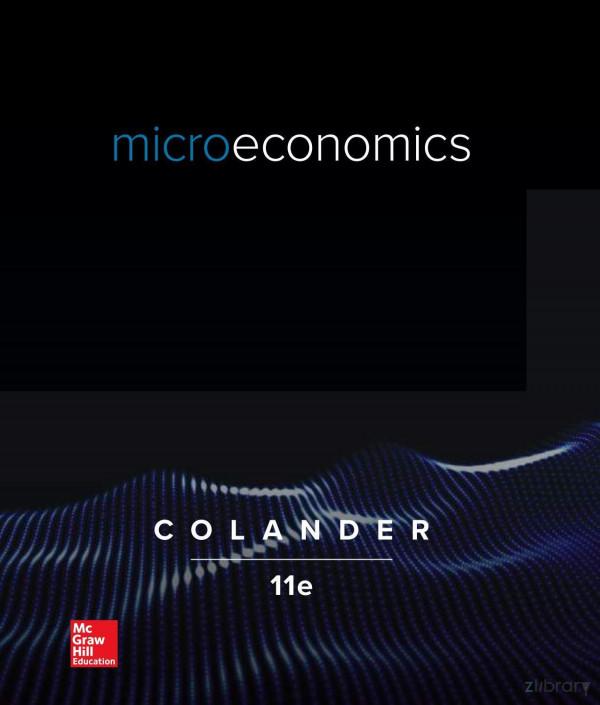UAVCommunicationsfor5GandBeyond
Editedby YongZeng
SoutheastUniversity,China Jiangsu,China and PurpleMountainLaboratories Jiangsu,China
IsmailGuvenc
NorthCarolinaStateUniversity NC,USA
RuiZhang
NationalUniversityofSingapore
Singapore
GiovanniGeraci UniversitatPompeuFabra Barcelona,Spain
DavidW.Matolak UniversityofSouthCarolina SC,USA
Thiseditionfirstpublished2021 ©2021JohnWiley&SonsLtd
Allrightsreserved.Nopartofthispublicationmaybereproduced,storedinaretrievalsystem,or transmitted,inanyformorbyanymeans,electronic,mechanical,photocopying,recordingorotherwise, exceptaspermittedbylaw.Adviceonhowtoobtainpermissiontoreusematerialfromthistitleisavailable athttp://www.wiley.com/go/permissions.
TherightofYongZeng,IsmailGuvenc,RuiZhang,GiovanniGeraci,andDavidW.Matolaktobeidentified astheauthorsofthiseditorialworkhasbeenassertedinaccordancewithlaw.
RegisteredOffices
JohnWiley&Sons,Inc.,111RiverStreet,Hoboken,NJ07030,USA
JohnWiley&SonsLtd,TheAtrium,SouthernGate,Chichester,WestSussex,PO198SQ,UK
EditorialOffice
TheAtrium,SouthernGate,Chichester,WestSussex,PO198SQ,UK
Fordetailsofourglobaleditorialoffices,customerservices,andmoreinformationaboutWileyproducts visitusatwww.wiley.com.
Wileyalsopublishesitsbooksinavarietyofelectronicformatsandbyprint-on-demand.Somecontentthat appearsinstandardprintversionsofthisbookmaynotbeavailableinotherformats.
LimitofLiability/DisclaimerofWarranty
Inviewofongoingresearch,equipmentmodifications,changesingovernmentalregulations,andthe constantflowofinformationrelatingtotheuseofexperimentalreagents,equipment,anddevices,the readerisurgedtoreviewandevaluatetheinformationprovidedinthepackageinsertorinstructionsfor eachchemical,pieceofequipment,reagent,ordevicefor,amongotherthings,anychangesinthe instructionsorindicationofusageandforaddedwarningsandprecautions.Whilethepublisherand authorshaveusedtheirbesteffortsinpreparingthiswork,theymakenorepresentationsorwarrantieswith respecttotheaccuracyorcompletenessofthecontentsofthisworkandspecificallydisclaimallwarranties, includingwithoutlimitationanyimpliedwarrantiesofmerchantabilityorfitnessforaparticularpurpose. Nowarrantymaybecreatedorextendedbysalesrepresentatives,writtensalesmaterialsorpromotional statementsforthiswork.Thefactthatanorganization,website,orproductisreferredtointhisworkasa citationand/orpotentialsourceoffurtherinformationdoesnotmeanthatthepublisherandauthors endorsetheinformationorservicestheorganization,website,orproductmayprovideorrecommendations itmaymake.Thisworkissoldwiththeunderstandingthatthepublisherisnotengagedinrendering professionalservices.Theadviceandstrategiescontainedhereinmaynotbesuitableforyoursituation. Youshouldconsultwithaspecialistwhereappropriate.Further,readersshouldbeawarethatwebsites listedinthisworkmayhavechangedordisappearedbetweenwhenthisworkwaswrittenandwhenitis read.Neitherthepublishernorauthorsshallbeliableforanylossofprofitoranyothercommercial damages,includingbutnotlimitedtospecial,incidental,consequential,orotherdamages.
LibraryofCongressCataloging-in-PublicationData
Names:Zeng,Yong(ProfessoratSoutheastUniversity),author.| Guvenc,Ismail(ProfessoratNorthCarolinaStateUniversity)|Zhang,Rui(ProfessoratNational UniversityofSingapore),author.|Geraci,Giovanni(AssistantProfessoratUniversitatPompeuFabra), author.|Matolak,DavidW.,author.|JohnWiley&Sons,Inc.,publisher.
Title:UAVcommunicationsfor5Gandbeyond/YongZeng,IsmailGuvenc,Rui Zhang,GiovanniGeraci,DavidW.Matolak.
Description:Hoboken,NJ:Wiley-IEEEPress,[2021]|Includes bibliographicalreferencesandindex.
Identifiers:LCCN2020030506(print)|LCCN2020030507(ebook)|ISBN 9781119575696(hardback)|ISBN9781119575672(adobepdf)|ISBN 9781119575726(epub)
Subjects:LCSH:Droneaircraft–Controlsystems.| Aeronautics–Communicationsystems.|Mobilecommunicationsystems.|5G mobilecommunicationsystems.
Classification:LCCTL589.4.Z4652021(print)|LCCTL589.4(ebook)| DDC629.135/5–dc23
LCrecordavailableathttps://lccn.loc.gov/2020030506
LCebookrecordavailableathttps://lccn.loc.gov/2020030507
CoverDesign:Wiley
CoverImage:©Waitforlight/GettyImages
Setin9.5/12.5ptSTIXTwoTextbySPiGlobal,Chennai,India 10987654321
Contents
ListofContributors xvii
Acronyms xxi
PartIFundamentalsofUAVCommunications 1
1Overview 3
QingqingWu,YongZeng,andRuiZhang
1.1UAVDefinitions,Classes,andGlobalTrend 3
1.2UAVCommunicationandSpectrumRequirement 4
1.3PotentialExistingTechnologiesforUAVCommunications 6
1.3.1DirectLink 6
1.3.2Satellite 7
1.3.3Ad-HocNetwork 8
1.3.4CellularNetwork 8
1.4TwoParadigmsinCellularUAVCommunications 9
1.4.1Cellular-ConnectedUAVs 9
1.4.2UAV-AssistedWirelessCommunications 10
1.5NewOpportunitiesandChallenges 11
1.5.1HighAltitude 11
1.5.2HighLoSProbability 12
1.5.3High3DMobility 12
1.5.4SWAPConstraints 13
1.6ChapterSummaryandMainOrganizationoftheBook 13 References 15
2ASurveyofAir-to-GroundPropagationChannelModelingfor UnmannedAerialVehicles 17
WahabKhawaja,IsmailGuvenc,DavidW.Matolak,Uwe-CarstenFiebig,andNicolas Schneckenberger
2.1Introduction 17
2.2LiteratureReview 20
2.2.1LiteratureReviewonAerialPropagation 20
2.2.2ExistingSurveysonUAVAGPropagation 21
2.3UAVAGPropagationCharacteristics 22
2.3.1ComparisonofUAVAGandTerrestrialPropagation 22
2.3.2FrequencyBandsforUAVAGPropagation 23
2.3.3ScatteringCharacteristicsforAGPropagation 24
2.3.4AntennaConfigurationsforAGPropagation 24
2.3.5DopplerEffects 25
2.4AGChannelMeasurements:Configurations,Challenges,Scenarios, andWaveforms 25
2.4.1ChannelMeasurementConfigurations 26
2.4.2ChallengesinAGChannelMeasurements 29
2.4.3AGPropagationScenarios 29
2.4.3.1OpenSpace 31
2.4.3.2Hilly/Mountainous 31
2.4.3.3Forest 32
2.4.3.4Water/Sea 32
2.4.4ElevationAngleEffects 32
2.5UAVAGPropagationMeasurementandSimulationResultsinthe Literature 33
2.5.1PathLoss/Shadowing 33
2.5.2DelayDispersion 36
2.5.3NarrowbandFadingandRicean K -factor 36
2.5.4DopplerSpread 37
2.5.5EffectsofUAVAGMeasurementEnvironment 37
2.5.5.1Urban/Suburban 38
2.5.5.2Rural/OpenField 38
2.5.5.3Mountains/Hilly,OverSea,Forest 39
2.5.6SimulationsforChannelCharacterization 40
2.6UAVAGPropagationModels 41
2.6.1AGPropagationChannelModelTypes 41
2.6.2Path-LossandLarge-ScaleFadingModels 42
2.6.2.1Free-SpacePath-LossModel 43
2.6.2.2Floating-InterceptPath-LossModel 43
2.6.2.3Dual-SlopePath-LossModel 43
2.6.2.4Log-DistancePath-LossModel 45
2.6.2.5ModifiedFSPLModel 45
2.6.2.6Two-RayPLModel 45
2.6.2.7Log-DistanceFIModel 45
2.6.2.8LOS/NLOSMixturePath-LossModel 46
2.6.3AirframeShadowing 47
2.6.4Small-ScaleFadingModels 47
2.6.5IntermittentMPCs 48
2.6.6EffectofFrequencyBandsonChannelModels 51
2.6.7MIMOAGPropagationChannelModels 52
2.6.8ComparisonofDifferentAGChannelModels 54
2.6.8.1Large-ScaleFadingModels 54
2.6.8.2Small-ScaleFadingModels 54
2.6.9ComparisonofTraditionalChannelModelswithUAVAGPropagationChannel Models 55
2.6.10RayTracingSimulations 56
2.6.113GPPChannelModelsforUAVs 58
2.7Conclusions 60 References 60
3UAVDetectionandIdentification 71
MartinsEzuma,FatihErden,ChethanKumarAnjinappa,OzgurOzdemir, IsmailGuvenc,andDavidMatolak
3.1Introduction 71
3.2RF-BasedUAVDetectionTechniques 75
3.2.1RFFingerprintingTechnique 76
3.2.2WiFiFingerprintingTechnique 76
3.3MultistageUAVRFSignalDetection 77
3.3.1PreprocessingStep:MultiresolutionAnalysis 78
3.3.2TheNaiveBayesianDecisionMechanismforRFSignalDetection 82
3.3.3DetectionofWiFiandBluetoothInterference 84
3.4UAVClassificationUsingRFFingerprints 89
3.4.1FeatureSelectionUsingNeighborhoodComponentsAnalysis(NCA) 91
3.5ExperimentalResults 92
3.5.1ExperimentalSetup 92
3.5.2DetectionResults 94
3.5.3UAVClassificationResults 95
3.6Conclusion 100 Acknowledgments 100 References 100
PartIICellular-ConnectedUAVCommunications 103
4PerformanceAnalysisforCellular-ConnectedUAVs 105 M.MahdiAzari,FernandoRosas,andSofiePollin
4.1Introduction 105
4.1.1Motivation 105
4.1.2RelatedWorks 107
4.1.3ContributionsandChapterStructure 108
4.2ModellingPreliminaries 109
4.2.1StochasticGeometry 109
4.2.2NetworkArchitecture 110
4.2.3ChannelModel 111
4.2.4BlockageModelingandLoSProbability 112
4.2.5UserAssociationStrategyandLinkSINR 112
4.3PerformanceAnalysis 112
4.3.1ExactCoverageProbability 113
4.3.2ApproximationsforUAVCoverageProbability 115
4.3.2.1DiscardingNLoSandNoiseEffects 116
4.3.2.2MomentMatching 116
4.3.3AchievableThroughputandAreaSpectralEfficiencyAnalysis 118
4.4SystemDesign:StudyCasesandDiscussion 119
4.4.1AnalysisofAccuracy 119
4.4.2DesignParameters 120
4.4.2.1ImpactofUAVAltitude 120
4.4.2.2ImpactofUAVAntennaBeamwidth 121
4.4.2.3ImpactofUAVAntennaTilt 123
4.4.2.4ImpactofDifferentTypesofEnvironment 123
4.4.3HeterogeneousNetworks–TierSelection 125
4.4.4NetworkDensification 127
4.5Conclusion 129 References 136
5PerformanceEnhancementsforLTE-ConnectedUAVs:Experiments andSimulations 139
RafhaelMedeirosdeAmorim,JeroenWigard,IstvánZ.Kovács, andTroelsB.Sørensen
5.1Introduction 139
5.2LTELiveNetworkMeasurements 140
5.2.1DownlinkExperiments 141
5.2.2Path-LossModelCharacterization 145
5.2.3UplinkExperiments 145
5.3PerformanceinLTENetworks 149
5.4ReliabilityEnhancements 150
5.4.1InterferenceCancellation 151
5.4.2Inter-CellInterferenceControl 152
5.4.3CoMP 152
5.4.4AntennaBeamSelection 153
5.4.5DualLTEAccess 155
5.4.6DedicatedSpectrum 158
5.4.7Discussion 158
5.5SummaryandOutlook 159 References 160
63GPPStandardizationforCellular-SupportedUAVs 163 Helka-LiinaMäättänen
6.1ShortIntroductiontoLTEandNR 163
6.1.1LTEPhysicalLayerandMIMO 165
6.1.2NRPhysicalLayerandMIMO 166
6.2DronesServedbyMobileNetworks 167
6.2.1InterferenceDetectionandMitigation 168
6.2.2MobilityforDrones 170
6.2.3NeedforDroneIdentificationandAuthorization 171
6.33GPPStandardizationSupportforUAVs 172
6.3.1MeasurementReportingBasedonRSRPLevelofMultipleCells 172
6.3.2Height,Speed,andLocationReporting 174
6.3.3UplinkPowerControlEnhancement 175
6.3.4FlightPathSignalling 175
6.3.5DroneAuthorizationandIdentification 176
6.4FlyingModeDetectioninCellularNetworks 177
References 179
7EnhancedCellularSupportforUAVswithMassiveMIMO 181 GiovanniGeraci,AdrianGarcia-Rodriguez,LorenzoGalatiGiordano, andDavidLópez-Pérez
7.1Introduction 181
7.2SystemModel 181
7.2.1CellularNetworkTopology 183
7.2.2SystemModel 184
7.2.3MassiveMIMOChannelEstimation 186
7.2.4MassiveMIMOSpatialMultiplexing 186
7.3Single-UserDownlinkPerformance 187
7.3.1UAVDownlinkC&CChannel 187
7.4MassiveMIMODownlinkPerformance 190
7.4.1UAVDownlinkC&CChannel 190
7.4.2UAV–GUEDownlinkInterplay 192
7.5EnhancedDownlinkPerformance 194
7.5.1UAVDownlinkC&CChannel 195
7.5.2UAV–GUEDownlinkInterplay 196
7.6UplinkPerformance 197
7.6.1UAVUplinkC&CChannelandDataStreaming 197
7.6.2UAV–GUEUplinkInterplay 198
7.7Conclusions 199 References 200
8High-CapacityMillimeterWaveUAVCommunications 203 NuriaGonzález-Prelcic,RobertW.Heath,CristianRusu,andAldebaroKlautau
8.1Motivation 203
8.2UAVRolesandUseCasesEnabledbyMillimeterWaveCommunication 206
8.2.1UAVRolesinCellularNetworks 206
8.2.2UAVUseCasesEnabledbyHigh-CapacityCellularNetworks 207
8.3AerialChannelModelsatMillimeterWaveFrequencies 208
8.3.1PropagationConsiderationsforAerialChannels 208
8.3.1.1AtmosphericConsiderations 208
8.3.1.2Blockages 210
x Contents
8.3.2Air-to-AirMillimeterWaveChannelModel 211
8.3.3Air-to-GroundMillimeterWaveChannelModel 212
8.3.4RayTracingasaTooltoObtainChannelMeasurements 214
8.4KeyAspectsofUAVMIMOCommunicationatmmWaveFrequencies 215
8.5EstablishingAerialmmWaveMIMOLinks 219
8.5.1BeamTrainingandTrackingforUAVMillimeterWaveCommunication 219
8.5.2ChannelEstimationandTrackinginAerialEnvironments 219
8.5.3DesignofHybridPrecodersandCombiners 221
8.6ResearchOpportunities 222
8.6.1SensingattheTower 222
8.6.2JointCommunicationandRadar 222
8.6.3PositioningandMapping 223
8.7Conclusions 223 References 223
PartIIIUAV-AssistedWirelessCommunications 231
9StochasticGeometry-BasedPerformanceAnalysisofDroneCellular Networks 233 MortezaBanagar,VishnuV.Chetlur,andHarpreetS.Dhillon
9.1Introduction 233
9.2OverviewoftheSystemModel 235
9.2.1SpatialModel 235
9.2.23GPP-InspiredMobilityModel 236
9.2.3ChannelModel 237
9.2.4MetricsofInterest 237
9.3AverageRate 238
9.4HandoverProbability 242
9.5ResultsandDiscussion 246
9.5.1DensityofInterferingDBSs 247
9.5.2AverageRate 247
9.5.3HandoverProbability 249
9.6Conclusion 250 Acknowledgment 251 References 251
10UAVPlacementandAerial–GroundInterferenceCoordination 255 AbhaykumarKumbharandIsmailGuvenc
10.1Introduction 255
10.2LiteratureReview 256
10.3UABSUseCaseforAG-HetNets 259
10.4UABSPlacementinAG-HetNet 260
10.5AG-HetNetDesignGuidelines 264
10.5.1Path-LossModel 265
10.5.1.1Log-DistancePath-LossModel 265
10.5.1.2Okumura–HataPath-LossModel 266
10.6Inter-CellInterferenceCoordination 266
10.6.1UEAssociationandScheduling 269
10.7SimulationResults 270
10.7.15pSEwithUABSsDeployedonHexagonalGrid 270
10.7.1.15pSEwithLog-NormalPath-LossModel 270
10.7.1.25pSEwithOkumura–HataPath-LossModel 271
10.7.25pSEwithGA-BasedUABSDeploymentOptimization 273
10.7.2.15pSEwithLog-NormalPath-LossModel 273
10.7.2.25pSEwithOkumura–HataPath-Lossmodel 275
10.7.3PerformanceComparisonBetweenFixed(Hexagonal)andOptimizedUABS DeploymentwitheICICandFeICIC 276
10.7.3.1InfluenceofLDPLMon5pSE 277
10.7.3.2InfluenceofOHPLMon5pSE 277
10.7.4ComparisonofComputationTimeforDifferentUABSDeployment Algorithms 277
10.8Concludingremarks 279 References 279
11JointTrajectoryandResourceOptimization 283 YongZeng,QingqingWu,andRuiZhang
11.1GeneralProblemFormulation 283
11.2InitialPathPlanningviatheTravelingSalesmanandPickup-and-Delivery Problems 285
11.2.1TSPwithoutReturn 286
11.2.2TSPwithGivenInitialandFinalLocations 287
11.2.3TSPwithNeighborhood 287
11.2.4Pickup-and-DeliveryProblem 288
11.3TrajectoryDiscretization 290
11.3.1TimeDiscretization 290
11.3.2PathDiscretization 291
11.4BlockCoordinateDescent 291
11.5SuccessiveConvexApproximation 292
11.6UnifiedAlgorithm 295
11.7Summary 296 References 296
12Energy-EfficientUAVCommunications 299 YongZengandRuiZhang
12.1UAVEnergyConsumptionModel 299
12.1.1Fixed-WingEnergyModel 300
12.1.1.1ForcesonaUAV 300
12.1.1.2StraightandLevelFlight 301
12.1.1.3CircularFlight 302
12.1.1.4ArbitraryLevelFlight 303
12.1.1.5Arbitrary3DFlight 304
12.1.2Rotary-WingEnergyModel 304
12.2EnergyEfficiencyMaximization 306
12.3EnergyMinimizationwithCommunicationRequirement 310
12.4UAV–GroundEnergyTrade-off 312
12.5ChapterSummary 312 References 313
13FundamentalTrade-OffsforUAVCommunications 315
QingqingWu,LiangLiu,YongZeng,andRuiZhang
13.1Introduction 315
13.2FundamentalTrade-offs 317
13.2.1Throughput–DelayTrade-Off 317
13.2.2Throughput–EnergyTrade-Off 318
13.2.3Delay–EnergyTrade-Off 319
13.3Throughput–DelayTrade-Off 319
13.3.1Single-UAV-EnabledWirelessNetwork 319
13.3.2Multi-UAV-EnabledWirelessNetwork 321
13.4Throughput–EnergyTrade-Off 323
13.4.1UAVPropulsionEnergyConsumptionModel 323
13.4.2Energy-ConstrainedTrajectoryOptimization 324
13.5FurtherDiscussionsandFutureWork 325
13.6ChapterSummary 327 References 327
14UAV–CellularSpectrumSharing 329
ChiyaZhangandWeiZhang
14.1Introduction 329
14.1.1CognitiveRadio 329
14.1.1.1OverlaySpectrumSharing 329
14.1.1.2UnderlaySpectrumSharing 330
14.1.2DroneCommunication 330
14.1.2.1UAVSpectrumSharing 331
14.1.2.2UAVSpectrumSharingwithExclusiveRegions 332
14.1.3ChapterOverview 333
14.2SNRMeta-DistributionofDroneNetworks 333
14.2.1StochasticGeometryAnalysis 333
14.2.2CharacteristicFunctionoftheSNRMeta-Distribution 334
14.2.3LOSProbability 338
14.3SpectrumSharingofDroneNetworks 338
14.3.1SpectrumSharinginSingle-TierDSCs 339
14.3.2SpectrumSharingwithCellularNetwork 342
14.4Summary 345 References 346
PartIVOtherAdvancedTechnologiesforUAV Communications 349
15Non-OrthogonalMultipleAccessforUAVCommunications 351 TianweiHou,YuanweiLiu,andXinSun
15.1Introduction 351
15.1.1Motivation 352
15.2User-CentricStrategyforEmergencyCommunications 352
15.2.1SystemModel 354
15.2.1.1Farusercase 354
15.2.1.2Nearusercase 355
15.2.2CoverageProbabilityoftheUser-CentricStrategy 356
15.3UAV-CentricStrategyforOffloadingActions 359
15.3.1SINRAnalysis 360
15.3.2CoverageProbabilityoftheUAV-CentricStrategy 361
15.4NumericalResults 364
15.4.1User-CentricStrategy 365
15.4.2UAV-CentricStrategy 367
15.5Conclusions 369 References 369
16PhysicalLayerSecurityforUAVCommunications 373 NadisankaRupasinghe,YavuzYapici,IsmailGuvenc,HuaiyuDai, andArupjyotiBhuyan
16.1Introduction 373
16.2BreachingSecurityinWirelessNetworks 374
16.2.1Denial-of-ServiceAttacks 374
16.2.2MasqueradeAttacks 374
16.2.3MessageModificationAttacks 374
16.2.4EavesdroppingIntruders 375
16.2.5TrafficAnalysis 375
16.3WirelessNetworkSecurityRequirements 375
16.3.1Authenticity 375
16.3.2Confidentiality 376
16.3.3Integrity 376
16.3.4Availability 376
16.4PhysicalLayerSecurity 376
16.4.1PhysicalLayerversusUpperLayers 377
16.4.2PhysicalLayerSecurityTechniques 377
16.4.2.1ArtificialNoise 378
16.4.2.2CooperativeJamming 378
16.4.2.3ProtectedZone 378
16.5PhysicalLayerSecurityforUAVs 379
16.5.1UAVTrajectoryDesigntoEnhancePLS 379
16.5.2CooperativeJammingtoEnhancePLS 381
16.5.3Spectral-andEnergy-EfficientPLSTechniques 382
16.6ACaseStudy:SecureUAVTransmission 383
16.6.1SystemModel 383
16.6.1.1LocationDistributionandmmWaveChannelModel 385
16.6.2ProtectedZoneApproachforEnhancingPLS 385
16.6.3SecureNOMAforUAVBSDownlink 386
16.6.3.1SecrecyOutageandSumSecrecyRates 386
16.6.3.2ShapeOptimizationforProtectedZone 388
16.6.3.3NumericalResults 389
16.6.3.4LocationoftheMostDetrimentalEavesdropper 389
16.6.3.5ImpactoftheProtectedZoneShapeonSecrecyRates 390
16.6.3.6VariationofSecrecyRateswithAltitude 391 Summary 392 References 393
17UAV-EnabledWirelessPowerTransfer 399 JieXu,YongZeng,andRuiZhang
17.1Introduction 399
17.2SystemModel 401
17.3Sum-EnergyMaximization 402
17.4Min-EnergyMaximizationunderInfiniteChargingDuration 403
17.4.1Multi-Location-HoveringSolution 404
17.5Min-EnergyMaximizationUnderFiniteChargingDuration 407
17.5.1SuccessiveHover-and-FlyTrajectoryDesign 407
17.5.1.1FlyingDistanceMinimizationtoVisit Γ HoveringLocations 407
17.5.1.2HoveringTimeAllocationWhen T ≥ Tfly 408
17.5.1.3TrajectoryRefinementWhen T < Tfly 409
17.5.2SCA-BasedTrajectoryDesign 409
17.6NumericalResults 411
17.7ConclusionandFutureResearchDirections 413 References 415
18Ad-HocNetworksintheSky 417 KameshNamuduri
18.1CommunicationSupportforUAVs 417
18.1.1SatelliteConnectivity 418
18.1.2CellularConnectivity 420
18.1.3AerialConnectivity 420
18.2TheMobilityChallenge 421
18.2.1UAS-to-UASCommunication 421
18.2.2MobilityModels 422
18.3EstablishinganAd-HocNetwork 423
18.3.1NetworkAddressing 424
18.3.2Routing 425
18.4Standards 426
18.4.1ASTM:RemoteIDforUAS 426
18.4.2EUROCAE:Safe,Secure,andEfficientUASOperations 426
18.4.33GPP:4GLTEand5GSupportforConnectedUASOperations 426
18.4.4IEEEP1920.1:AerialCommunicationsandNetworkingStandards 427
18.4.5IEEEP1920.2:Vehicle-to-VehicleCommunicationsStandardforUAS 427
18.5TechnologiesandProducts 427
18.5.1SilvusStreamcaster 427
18.5.2goTenna 427
18.5.3MPU5andWaveRelayfromPersistentSystems 428
18.5.4KineticMeshNetworksfromRajant 428
18.6Software-DefinedNetworkasaSolutionforUAVNetworks 428
18.7Summary 429 References 429
Index 433
ListofContributors
RafhaelMedeirosdeAmorim NokiaBellLabs
Denmark
ChethanKumarAnjinappa DepartmentofElectricalandComputer Engineering
NorthCarolinaStateUniversity NC USA
M.MahdiAzari DepartmentofElectricalEngineering
KULeuven Belgium
MortezaBanagar Wireless@VT BradeyDepartmentofElectricaland ComputerEngineering VirginiaTech
Blacksburg VA USA
ArupjyotiBhuyan IdahoNationalLaboratory IdahoFalls
ID USA
VishnuV.Chetlur Wireless@VT
BradeyDepartmentofElectricaland ComputerEngineering VirginiaTech
Blacksburg VA USA
HuaiyuDai DepartmentofElectricalandComputer Engineering
NorthCarolinaStateUniversity NC USA
HarpreetS.Dhillon Wireless@VT
BradeyDepartmentofElectricaland ComputerEngineering VirginiaTech
Blacksburg VA USA
FatihErden DepartmentofElectricalandComputer Engineering
NorthCarolinaStateUniversity NC USA
xviii ListofContributors
MartinsEzuma DepartmentofElectricalandComputer Engineering
NorthCarolinaStateUniversity NC USA
Uwe-CarstenFiebig InstituteofCommunicationsand Navigation
GermanAerospaceCenter(DLR) Wessling Germany
RobertW.Heath ElectricalandComputerEngineering Department
UniversityofTexasatAustin USA
LorenzoGalatiGiordano NokiaBellLabs
Dublin Ireland
AdrianGarcia-Rodriguez
NokiaBellLabs
Dublin
Ireland
GiovanniGeraci UniversitatPompeuFabra Barcelona Spain
NuriaGonzález-Prelcic ElectricalandComputerEngineering Department
UniversityofTexasatAustin USA
IsmailGuvenc DepartmentofElectricalandComputer Engineering
NorthCarolinaStateUniversity NC USA
TianweiHou SchoolofElectronicandInformation Engineering
BeijingJiaotongUniversity PRChina
WahabKhawaja DepartmentofElectricalandComputer Engineering
NorthCarolinaStateUniversity NC USA
AldebaroKlautau ComputerandTelecommunication EngineeringDepartment UniversidadeFederaldoPará
Brazil
IstvánZ.Kovács NokiaBellLabs
Denmark
AbhaykumarKumbhar DepartmentofElectricalandComputer Engineering
FloridaInternationalUniversity Miami USA
LiangLiu DepartmentofElectronicandInformation Engineering
TheHongKongPolytechnicUniversity HongKong
YuanweiLiu SchoolofElectronicEngineeringand ComputerScience
QueenMaryUniversityofLondon UK
DavidLópez-Pérez NokiaBellLabs
Dublin Ireland
DavidW.Matolak DepartmentofElectricalEngineering UniversityofSouthCarolina SC USA
Helka-LiinaMäättänen EricssonResearch Finland
KameshNamuduri UniversityofNorthTexas USA
OzgurOzdemir DepartmentofElectricalandComputer Engineering NorthCarolinaStateUniversity NC USA
SofiePollin DepartmentofElectricalEngineering KULeuven Belgium
FernandoRosas DataScienceInstitute DepartmentofBrainSciences andCenterforComplexityScience ImperialCollegeLondon UK
NadisankaRupasinghe DepartmentofElectricalandComputer Engineering NorthCarolinaStateUniversity NC USA and DOCOMOInnovations,Inc. PaloAlto CA USA
CristianRusu LCSL IstitutoItalianodiTecnologia(IIT) Liguria Italy
NicolasSchneckenberger InstituteofCommunicationsand Navigation GermanAerospaceCenter(DLR) Wessling Germany
TroelsB.Sørensen AalborgUniversity Denmark
XinSun SchoolofElectronicandInformation Engineering BeijingJiaotongUniversity PRChina
JeroenWigard NokiaBellLabs Denmark
QingqingWu StateKeyLaboratoryofInternetofThings forSmartCity UniversityofMacau China
JieXu FutureNetworkofIntelligenceInstitute (FNii)andSchoolofScienceand Engineering
TheChineseUniversityofHongKong Shenzhen PRChina
xx ListofContributors
YavuzYapici DepartmentofElectricalandComputer Engineering
NorthCarolinaStateUniversity NC USA
ChiyaZhang SchoolofElectronicandInformation Engineering
HarbinInstituteofTechnology Shenzhen China and PengChengLaboratory(PCL) Shenzhen China
RuiZhang DepartmentofElectricalandComputer Engineering NationalUniversityofSingapore Singapore
WeiZhang SchoolofElectricalEngineeringand Telecommunications UniversityofNewSouthWales Sydney Australia
YongZeng NationalMobileCommunications ResearchLaboratory SoutheastUniversity China and PurpleMountainLaboratories Jiangsu China
Acronyms
3GPP3rd/thirdgenerationpartnershipproject
5G5th/fifthgeneration
5pSE5th/fifthpercentilespectralefficiency
AAair-to-air
AGair-to-ground
AG-HetNetair–groundheterogeneouscellularnetwork
ASEareaspectralefficiency
ASTAarrivalsseetimeaverages
AWGNadditivewhiteGaussiannoise
B5Gbeyond5th/fifthgeneration
b/s/Hzbitspersecondperhertz
BERbiterrorrate
BHCAbusyhourcallattempts
BPPbinomialpointprocess
BPSKbinaryphaseshiftkeying
BRbandwidthreservation
BSbasestation
BSs/km2 basestationspersquarekilometer
b.u.bandwidthunit(s)
BVLoSbeyond-visual-line-of-sight
BWbandwidth
C2commandandcontrol
CACcall/connectionadmissioncontrol
CBPcallblockingprobability(-ies)
CCDFcomplementarycumulativedistributionfunction
CCScentumcallseconds
CDFcumulativedistributionfunction
CDTMconnectiondependentthresholdmodel
CE2RcurvedEarthtwo-ray
CFOcarrierfrequencyoffset
CIclose-in
CIRchannelimpulseresponse
CNPCcontrolandnon-payloadcommunications
Acronyms
CREcellrangeexpansion
CScompletesharing
CSFcoordinatedradiosubframe
CSIchannelstateinformation
CTFchanneltransferfunction
CWcontinuouswave
DBSdronebasestation
DiffServdifferentiatedservices
DMEdistance-measuringequipment
DPPDopplerpowerprofile
DSdualslope
DSB-AMdouble-sidebandamplitudemodulation
DS-SSdirectsequencespreadspectrum
EMLMErlangmultiratelossmodel
eICICenhancedinter-cellinterferencecoordination
erltheErlangunitoftraffic-load
FAAfederalaviationadministration
FBMCfilterbankmulticarrier
FCCfederalcommunicationscommission
FeICICfurther-enhancedinter-cellinterferencecoordination
FIfloatingintercept
FIFOfirstin-firstout
FMCWfrequency-modulatedcontinuouswave
Freq.frequency
FSPLfree-spacepathloss
GAgeneticalgorithm
GBSCMgeometricallybasedstochasticchannelmodel
GMSKGaussianminimumshiftkeying
GPSglobalpositioningsystem
GSgroundstation
GSa/sgigasamplespersecond
GSMglobalsystemformobilecommunication
GUEgrounduser/grounduserequipment
HAPhigh-altitudeplatform
HDhighdefinition
HetNetheterogeneousnetwork
ICIinter-carrierinterference
ICICinter-cellinterferencecoordination
IMPCintermittentmultipathcomponent
Infs.infrastructure
IS-GBSCMirregular-shapedgeometric-basedstochasticchannelmodel
ITUInternationalTelecommunicationUnion
kbpskilobitspersecond
LAPlow-altitudeplatform
LDACSL-banddigitalaeronauticalcommunicationssystems
LDPLMlog-distancepath-lossmodel
LoS/LOSline-of-sight
LTElong-termevolution
LUILisbonUniversityInstitute
mAhmilli-amphour
Mbpsmegabitspersecond
MBSmacrobasestation
mgfmomentgeneratingfunction
MIMOmultipleinput–multipleoutput
MISOmultipleinput–singleoutput
mmWavemillimeterwave
Mod.sig.modulatedsignal
MOIMBScellofinterest/macrobasestationcellofinterest
MPCmultipathcomponent
mphmilesperhour
MSKminimumshiftkeying
MUEMBSGUE/macrobasestationgrounduserequipment
N/Anotapplicable/notavailable
NGSCMnon-geometricstochasticchannelmodel
NLoS/NLOSnon-line-of-sight
OFDMorthogonalfrequency-divisionmultiplexing
OHPLMOkumura–Hatapath-lossmodel
OLOSobstructedline-of-sight
PAPRpeak-to-average-powerratio
PBSpicobasestation
PDFprobabilitydensityfunction
PDPpowerdelayprofile
PGpathgain
pgflprobabilitygeneratingfunctional
PLpathloss
PLEpath-lossexponent
PPPPoissonpointprocess
PRNpseudo-randomnumber
PSCpublicsafetycommunications
PSDpowerspectraldensity
QoSqualityofservice
REDrandomearlydetection
RFradiofrequency
RHSRighthandside
RMaruralmacro
RMS-DSroot-mean-squaredelayspread
RS-GBSCMregular-shapedgeometric-basedstochasticchannelmodel
RSRPreferencesymbolreceivedpower
RSRQreferencesignalreceivequality
RSSreceivedsignalstrength
xxiv Acronyms
RSSIreceivedsignalstrengthindicator
RTTround-triptime
r.v.randomvariable(s)
RWrandomwalk
RWPrandomwaypoint
RXreceiver
Satel.satellite
SDMAspace-divisionmultipleaccess
SEspectralefficiency
SIMOsingleinput–multipleoutput
SINRsignal-to-interference-plus-noiseratio
SIRsignal-to-interferenceratio
SIROserviceinrandomorder
SISOsingleinput–singleoutput
SNRsignal-to-noiseratio
TDLtappeddelayline
TDMAtimedivisionmultipleaccess
Terres.terrestrial
TOAtimeofarrival
TXtransmitter
UABSunmannedaerialbasestation
UASunmannedaircraftsystem/unmannedaerialsystem
UAVunmannedaerialvehicle
UDMuser-dependentmodel
UEuser/userequipment
UIMuser-independentmodel
UMaurbanmacro
UMiurbanmicro
UMTSuniversalmobiletelecommunicationsservice
UOIUABScellofinterest/unmannedaerialbasestationcellofinterest
USFuncoordinatedradiosubframe
UUEUABSGUE/unmannedaerialbasestationgrounduserequipment
UWBultra-wideband
V2Vvehicle-to-vehicle
Vehic.vehicular
VHFveryhighfrequency
WSSwide-sensestationary

